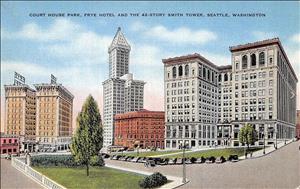On June 2, 1937, the King County Board of County Commissioners approves the County's first zoning resolution. The action comes two years after a state law allows counties to establish planning commissions and prepare coordinated plans governing land development. The zoning resolution regulates future development by dividing unincorporated areas of the County into districts where different types of land uses are allowed. The extension of zoning to rural areas is an innovative step. Zoning within cities dates back to the first years of the twentieth century, but King County is only the third county in the nation to adopt rural zoning.
Comprehensive zoning, in which a government divides its territory into districts and sets different land use restrictions for each district, was first adopted by New York City in 1916. The zoning movement was a response to uncontrolled growth, which often led to overcrowding, mixing of incompatible uses, and urban blight. Following New York's example and encouraged by the United States Department of Commerce, many cities and some smaller communities adopted zoning over the next decades. Some land owners argued that zoning restrictions were unconstitutional, but in the landmark 1926 decision Village of Euclid v. Ambler Realty Company the United States Supreme Court ruled that zoning is a constitutionally permitted exercise of the "police power" to enact regulations related to public health, safety, and welfare.
The Planning Commission
In 1935, the state Legislature authorized Washington counties, cities, and towns to create planning commissions and to adopt and enforce zoning plans. King County had actually had an advisory Planning Commission since 1926 and had created a new Commission in 1934. After the Legislature passed the Planning Commissions Act, the Board of County Commissioners reorganized the Commission in accordance with the state law, and appointed 12 members on June 24, 1935. Over the next two years, the Planning Commission prepared a zoning code for the County.
The Board of County Commissioners adopted the zoning code on June 2, 1937, by passing General Resolution Number 6494, which established land classifications and use regulations within the unincorporated territory of King County and adopted a map that would show the different classified use districts. (Territory located within incorporated cities was subject to city rather than County regulation.) As the state Supreme Court explained:
"In order to classify, regulate, restrict, and segregate the uses of land, buildings, and structures ... the resolution divides the unincorporated territory of King County into various classes of use districts denominated, respectively, residence, suburban, agricultural, business, commercial, manufacturing, industrial, forestry, forestry recreational, watershed, landing field, and unclassified districts" (Park v. Stolzheise).More Precise Classification
Initially all of the unincorporated County area was designated on the map as an unclassified use district in which all uses were permitted with only a few exceptions, but the resolution also directed that "[t]he Planning Commission shall, as rapidly as is, in its judgment feasible, proceed with the more precise classification of the unincorporated territory of King County" (Park v. Stolzheise). These classifications into the more specified use districts were shown on area maps that the Planning Commission began preparing for adoption by the County Commissioners.
The Planning Commission focused its first mapping efforts on rapidly urbanizing areas, beginning in 1940 with Mercer Island, where the first Lake Washington Floating Bridge had just opened, providing a quick connection to Seattle and sparking growth. Over the years, in addition to adopting the district area maps, the County Commissioners made various changes and revisions to the zoning code.
Then in 1958, a Superior Court judge ruled that all King County zoning since the adoption of Resolution 6494 in 1937 was invalid because the County had not properly followed the procedures of the Planning Commissions Act. Although the County could have appealed (the state Supreme Court later rejected a similar challenge to Seattle zoning), the Planning Commission instead quickly prepared and the County Commissioners adopted a new comprehensive zoning plan and zoning code.

